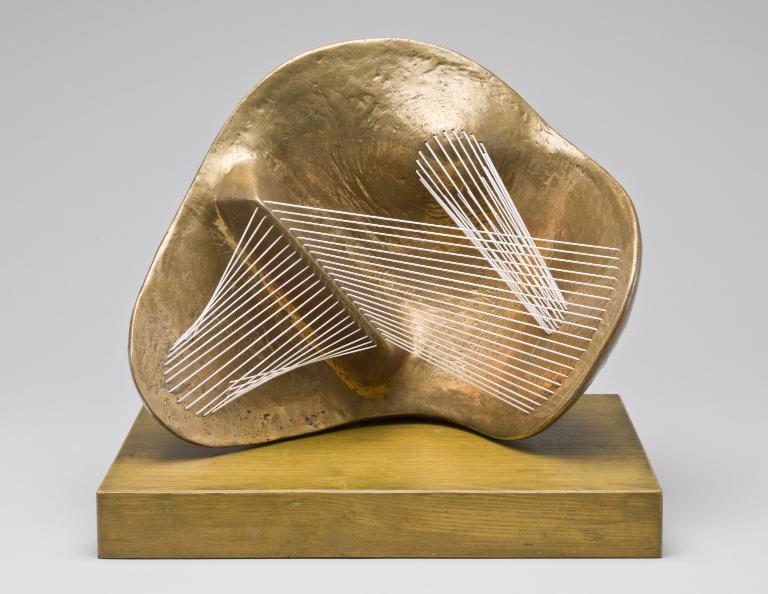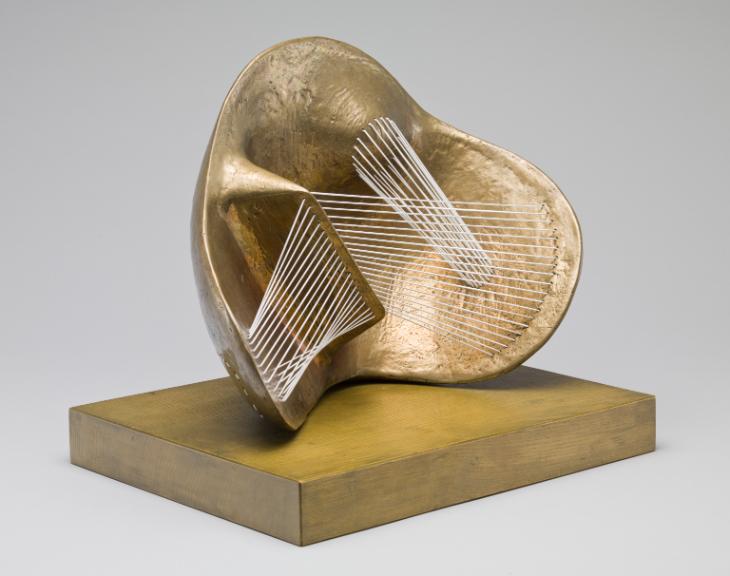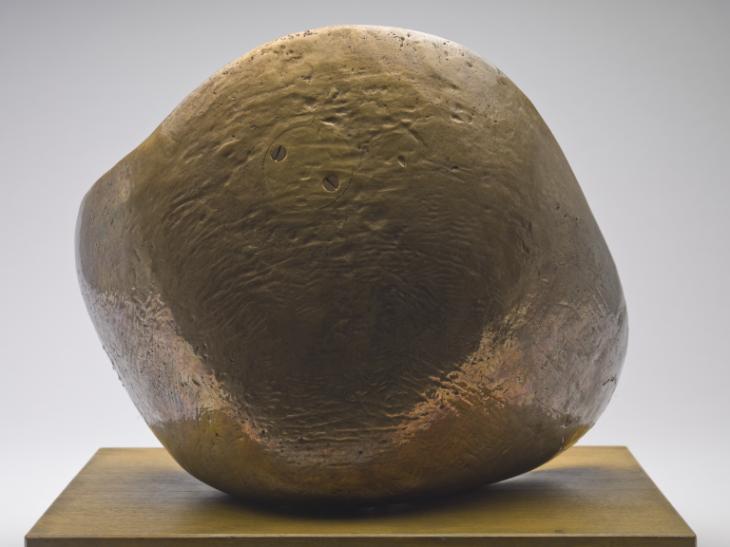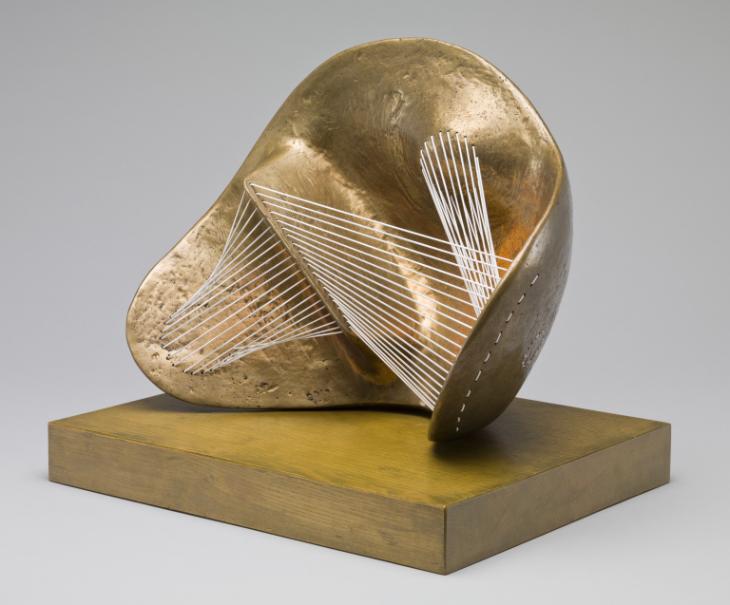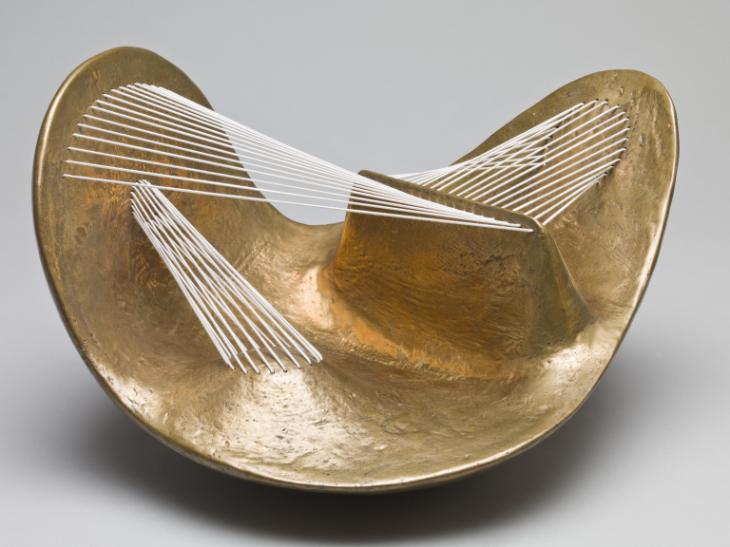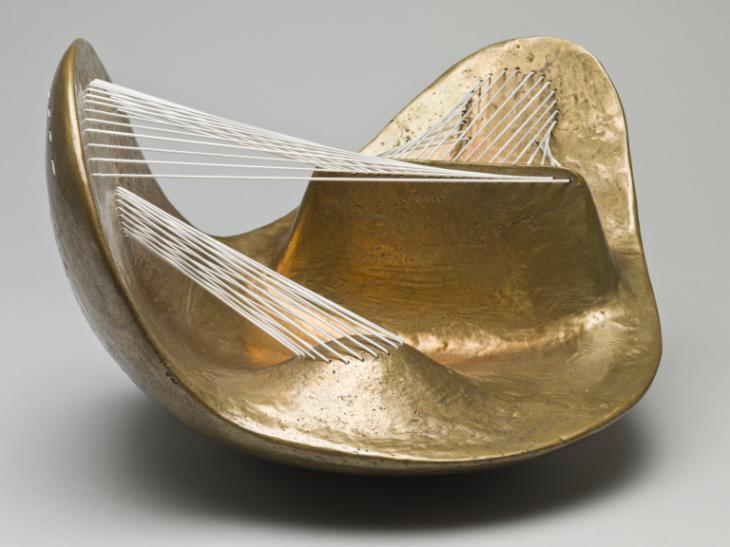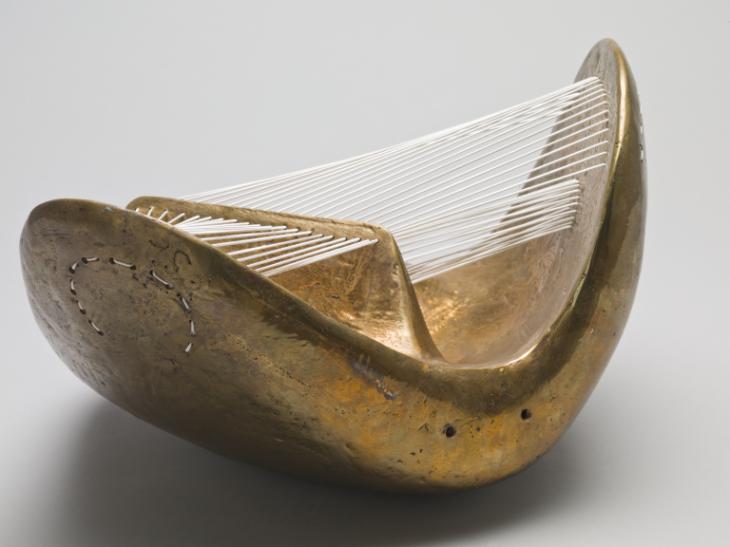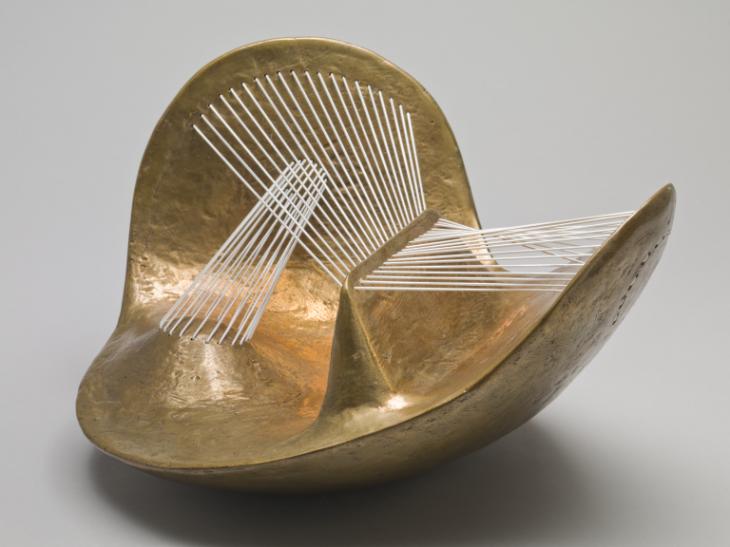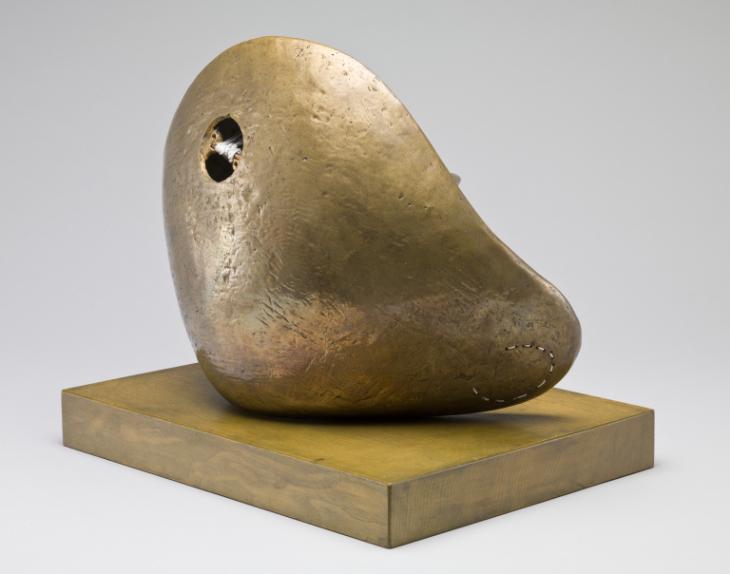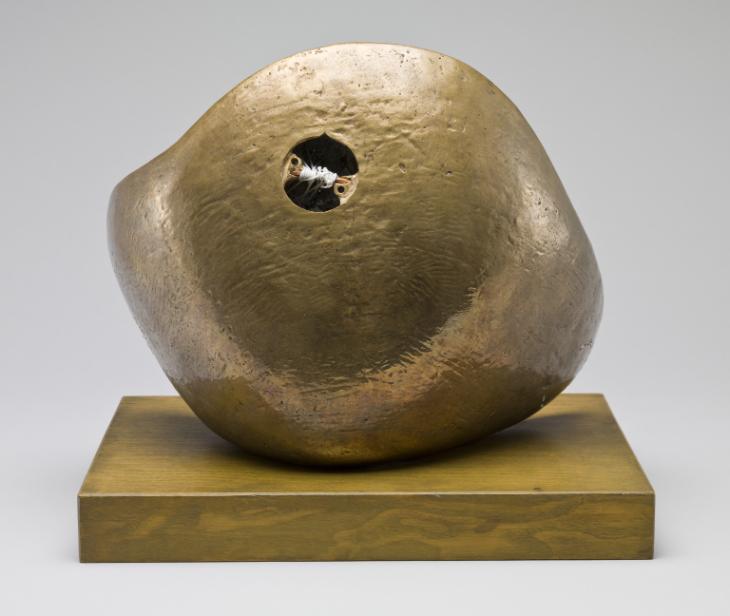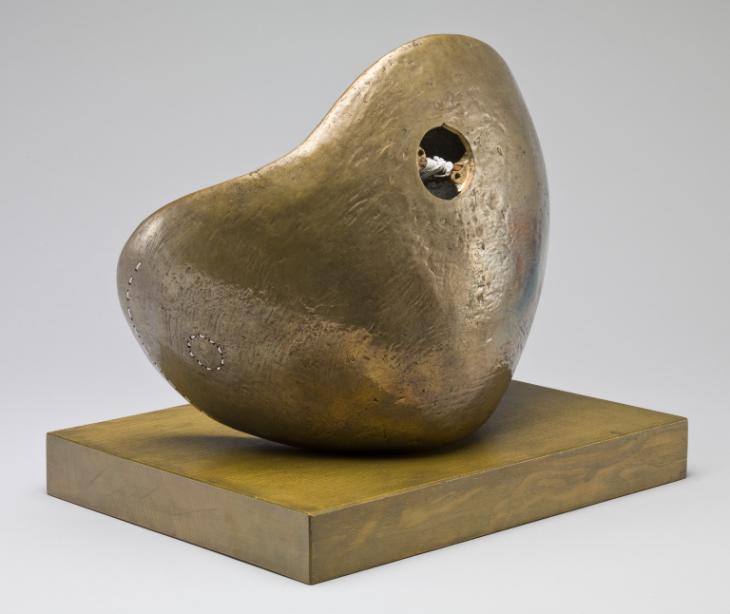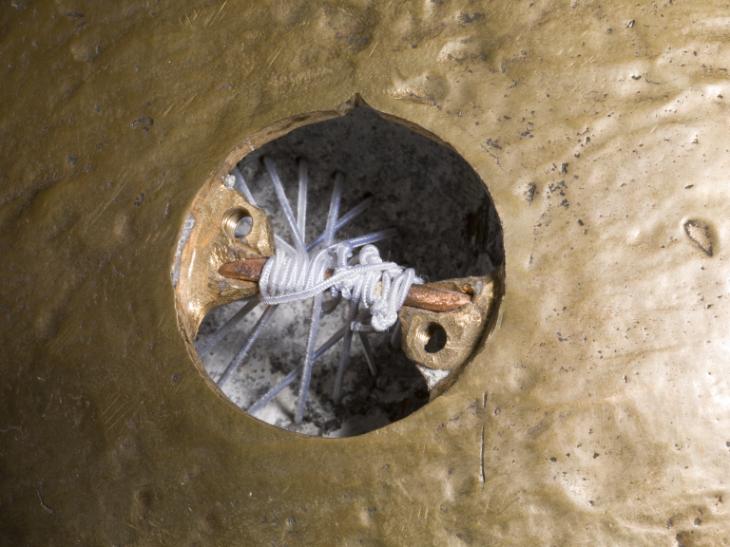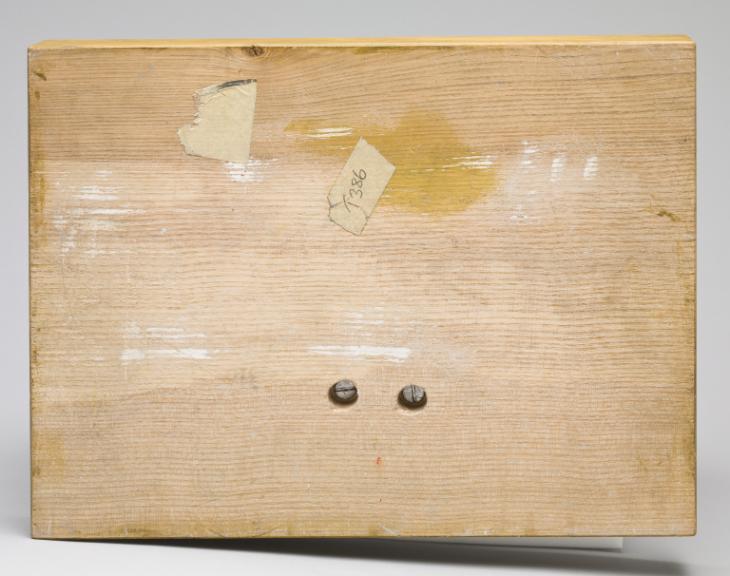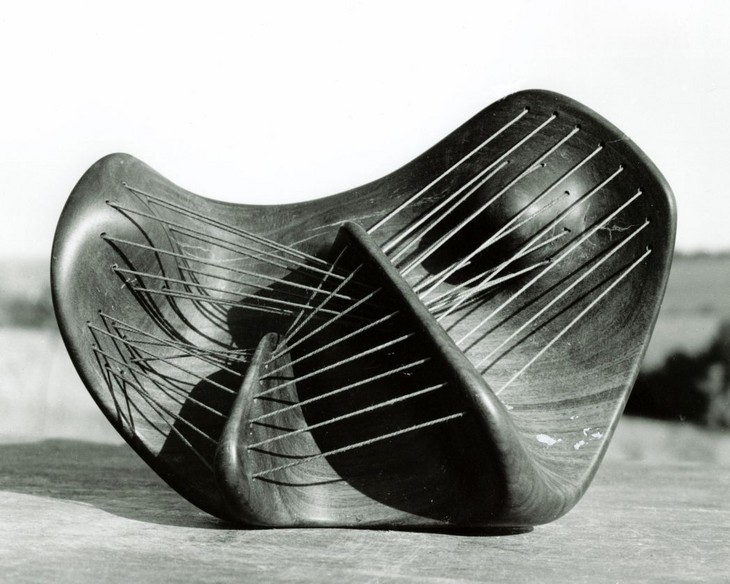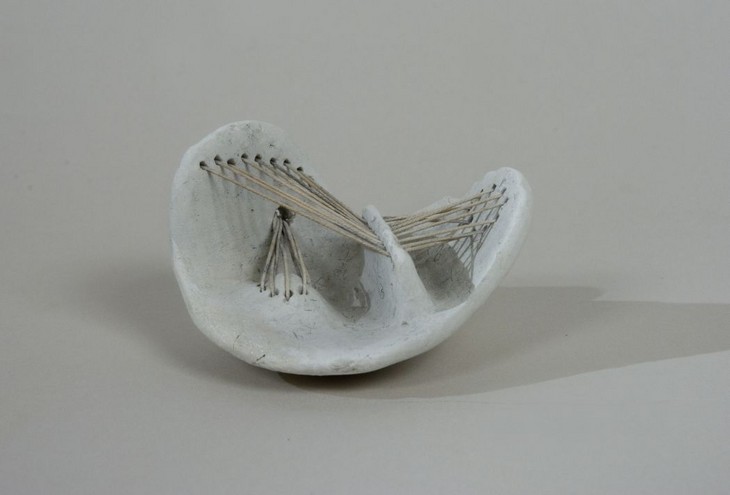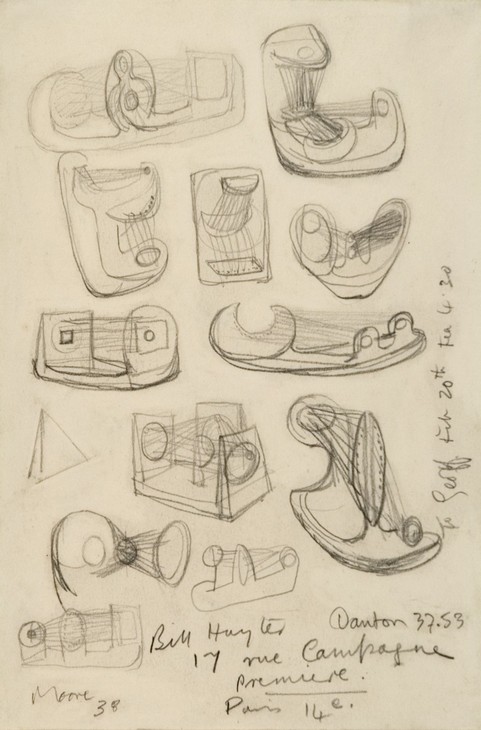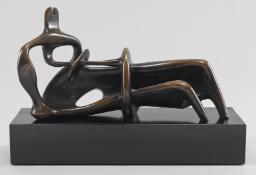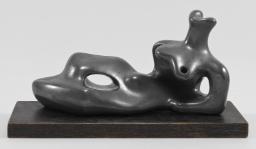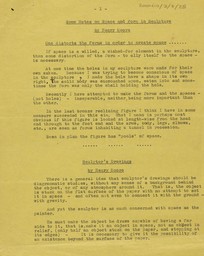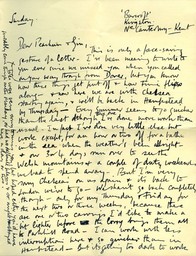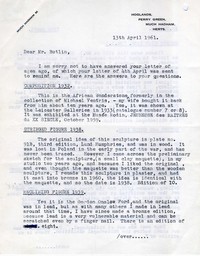Henry Moore OM, CH Stringed Figure 1938, cast 1960
Image 1 of 15
-
 Henry Moore OM, CH, Stringed Figure 1938, cast 1960© The Henry Moore Foundation. All Rights Reserved© The Henry Moore Foundation. All Rights Reserved
Henry Moore OM, CH, Stringed Figure 1938, cast 1960© The Henry Moore Foundation. All Rights Reserved© The Henry Moore Foundation. All Rights Reserved -
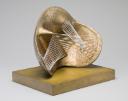 Henry Moore OM, CH, Stringed Figure 1938, cast 1960© The Henry Moore Foundation. All Rights Reserved© The Henry Moore Foundation. All Rights Reserved
Henry Moore OM, CH, Stringed Figure 1938, cast 1960© The Henry Moore Foundation. All Rights Reserved© The Henry Moore Foundation. All Rights Reserved -
 Henry Moore OM, CH, Stringed Figure 1938, cast 1960© The Henry Moore Foundation. All Rights Reserved© The Henry Moore Foundation. All Rights Reserved
Henry Moore OM, CH, Stringed Figure 1938, cast 1960© The Henry Moore Foundation. All Rights Reserved© The Henry Moore Foundation. All Rights Reserved -
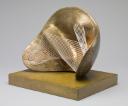 Henry Moore OM, CH, Stringed Figure 1938, cast 1960© The Henry Moore Foundation. All Rights Reserved© The Henry Moore Foundation. All Rights Reserved
Henry Moore OM, CH, Stringed Figure 1938, cast 1960© The Henry Moore Foundation. All Rights Reserved© The Henry Moore Foundation. All Rights Reserved -
 Henry Moore OM, CH, Stringed Figure 1938, cast 1960© The Henry Moore Foundation. All Rights Reserved© The Henry Moore Foundation. All Rights Reserved
Henry Moore OM, CH, Stringed Figure 1938, cast 1960© The Henry Moore Foundation. All Rights Reserved© The Henry Moore Foundation. All Rights Reserved -
 Henry Moore OM, CH, Stringed Figure 1938, cast 1960© The Henry Moore Foundation. All Rights Reserved© The Henry Moore Foundation. All Rights Reserved
Henry Moore OM, CH, Stringed Figure 1938, cast 1960© The Henry Moore Foundation. All Rights Reserved© The Henry Moore Foundation. All Rights Reserved -
 Henry Moore OM, CH, Stringed Figure 1938, cast 1960© The Henry Moore Foundation. All Rights Reserved© The Henry Moore Foundation. All Rights Reserved
Henry Moore OM, CH, Stringed Figure 1938, cast 1960© The Henry Moore Foundation. All Rights Reserved© The Henry Moore Foundation. All Rights Reserved -
 Henry Moore OM, CH, Stringed Figure 1938, cast 1960© The Henry Moore Foundation. All Rights Reserved© The Henry Moore Foundation. All Rights Reserved
Henry Moore OM, CH, Stringed Figure 1938, cast 1960© The Henry Moore Foundation. All Rights Reserved© The Henry Moore Foundation. All Rights Reserved -
 Henry Moore OM, CH, Stringed Figure 1938, cast 1960© The Henry Moore Foundation. All Rights Reserved© The Henry Moore Foundation. All Rights Reserved
Henry Moore OM, CH, Stringed Figure 1938, cast 1960© The Henry Moore Foundation. All Rights Reserved© The Henry Moore Foundation. All Rights Reserved -
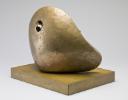 Henry Moore OM, CH, Stringed Figure 1938, cast 1960© The Henry Moore Foundation. All Rights Reserved© The Henry Moore Foundation. All Rights Reserved
Henry Moore OM, CH, Stringed Figure 1938, cast 1960© The Henry Moore Foundation. All Rights Reserved© The Henry Moore Foundation. All Rights Reserved -
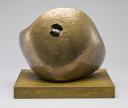 Henry Moore OM, CH, Stringed Figure 1938, cast 1960© The Henry Moore Foundation. All Rights Reserved© The Henry Moore Foundation. All Rights Reserved
Henry Moore OM, CH, Stringed Figure 1938, cast 1960© The Henry Moore Foundation. All Rights Reserved© The Henry Moore Foundation. All Rights Reserved -
 Henry Moore OM, CH, Stringed Figure 1938, cast 1960© The Henry Moore Foundation. All Rights Reserved© The Henry Moore Foundation. All Rights Reserved
Henry Moore OM, CH, Stringed Figure 1938, cast 1960© The Henry Moore Foundation. All Rights Reserved© The Henry Moore Foundation. All Rights Reserved -
 Henry Moore OM, CH, Stringed Figure 1938, cast 1960© The Henry Moore Foundation. All Rights Reserved© The Henry Moore Foundation. All Rights Reserved
Henry Moore OM, CH, Stringed Figure 1938, cast 1960© The Henry Moore Foundation. All Rights Reserved© The Henry Moore Foundation. All Rights Reserved -
 Henry Moore OM, CH, Stringed Figure 1938, cast 1960© The Henry Moore Foundation. All Rights Reserved© The Henry Moore Foundation. All Rights Reserved
Henry Moore OM, CH, Stringed Figure 1938, cast 1960© The Henry Moore Foundation. All Rights Reserved© The Henry Moore Foundation. All Rights Reserved -
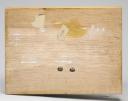 Henry Moore OM, CH, Stringed Figure 1938, cast 1960© The Henry Moore Foundation. All Rights Reserved© The Henry Moore Foundation. All Rights Reserved
Henry Moore OM, CH, Stringed Figure 1938, cast 1960© The Henry Moore Foundation. All Rights Reserved© The Henry Moore Foundation. All Rights Reserved
© The Henry Moore Foundation. All Rights Reserved
Henry Moore OM, CH,
Stringed Figure
1938, cast 1960
© The Henry Moore Foundation. All Rights Reserved
In 1960 Moore decided to remake in bronze a version of Stringed Figure, a wooden sculpture made in 1938 that had been lost in Poland during the Second World War. In so doing he revisited his use of string to create transparent surfaces, which had been a feature of his sculpture in the late 1930s.
Henry Moore OM, CH 1898–1986
Stringed Figure
1938, cast 1960
Bronze and elastic string on pine wood base
273 x 343 x 197 mm
Presented by the Friends of the Tate Gallery 1960
In an edition of 12 plus 1 artist’s copy
T00386
Stringed Figure
1938, cast 1960
Bronze and elastic string on pine wood base
273 x 343 x 197 mm
Presented by the Friends of the Tate Gallery 1960
In an edition of 12 plus 1 artist’s copy
T00386
Ownership history
Acquired directly from the artist by the Friends of the Tate Gallery, by whom presented to Tate in 1960.
Exhibition history
1973
Henry Moore to Gilbert & George: Modern British Art from the Tate Gallery, Palais des Beaux-Arts, Brussels, September–November 1973, no.28 (date given as 1938–40).
1978
The Henry Moore Gift, Tate Gallery, London, June–August 1978, no number.
1998
Henry Moore 1898–1986: ein Retrospektive zum 100 Geburtstag, Palais Harrach Kunsthistorisches Museum, Vienna, March–August 1998, no.60.
2005
Henry Moore y México, Museo Dolores Olmedo, Mexico City, June–October 2005, no.20.
References
1960
Matters of Modern Art: From 1840 to 1960, exhibition catalogue, Marlborough Fine Art, London 1960, no.88 (another cast reproduced).
1961
The Tate Gallery: Report of the Trustees for the Year 1 April 1960 to 31 March 1961, London 1961, p.26.
1962
Henry Moore, exhibition catalogue, Knoedler and Co., New York 1962, no.2 (another cast reproduced p.2).
1962
Henry Moore: Exhibition of Sculpture and Drawings, exhibition catalogue, Ashmolean Museum, Oxford 1962, no.2 (another cast reproduced pl.3).
1964
Mary Chamot, Dennis Farr and Martin Butlin, Tate Gallery Catalogues: The Modern British Paintings, Drawings and Sculpture, London 1964, p.456.
1968
John Hedgecoe (ed.), Henry Moore, London 1968, pp.100–7 (another cast reproduced pp.102–4).
1969
Henry Moore: Sculpture and Drawings from the Arts Council Collection, exhibition catalogue, Arts Council touring exhibition, London 1969 (another cast reproduced no.2).
1973
Henry Moore to Gilbert & George: Modern British Art from the Tate Gallery, exhibition catalogue, Palais des Beaux-Arts, Brussels 1973, no.28, reproduced p.50.
1978
The Henry Moore Gift, exhibition catalogue, Tate Gallery, London 1978, reproduced p.21.
1988
Penelope Curtis, Modern British Sculpture from the Collection, display catalogue, Tate Liverpool, Liverpool 1988, reproduced p.59.
1998
Henry Moore 1898–1986: ein Retrospektive zum 100 Geburtstag, exhibition catalogue, Palais Harrach Kunsthistorisches Museum, Vienna 1998, no.60, reproduced p.208.
1999
Alan Bowness (ed.), Henry Moore. Volume 6: Complete Sculpture 1980–86, 1988, revised edn, London 1999, no.186b (?another cast reproduced p.29 and pls.19–20).
2002
Timothée Trimm, Henry Moore: Intime, Paris 2002 (another cast reproduced p.32 as Stringed Bowl).
2005
Henry Moore y México, exhibition catalogue, Museo Dolores Olmedo, Mexico City 2005, reproduced p.50.
2007
David Mitchinson (ed.), Hoglands: The Home of Henry and Irina Moore, London 2007 (another cast reproduced 98).
2010
Gregor Muir (ed.), Henry Moore: Ideas for Sculpture, exhibition catalogue, Hauser & Wirth, London 2010, no.54 (another cast reproduced p.131).
2012
Intersections: Henry Moore and Stringed Surfaces, exhibition catalogue, Royal Society, London 2012 (another cast reproduced p.12).
2012
Henry Moore and the Arts Council Collection, exhibition catalogue, Arts Council touring exhibition, London 2012 (another cast reproduced pp.49–50).
Technique and condition
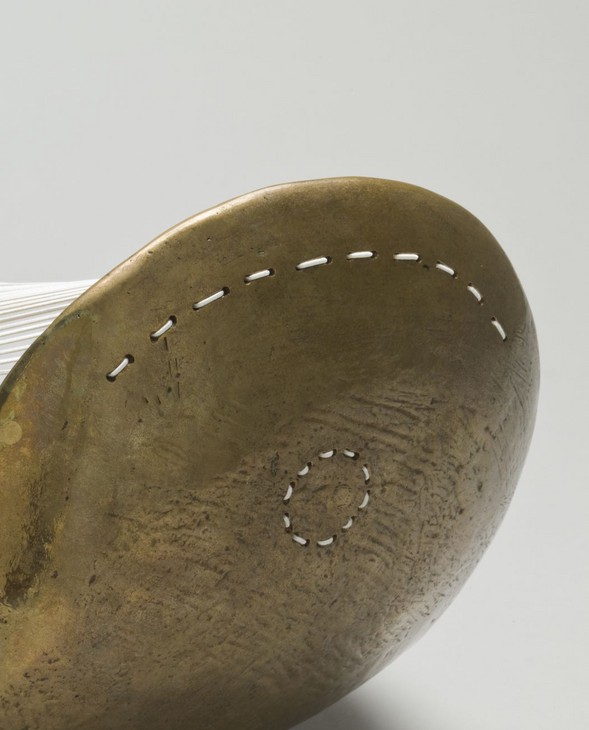
Detail of Stringed Figure 1938, cast 1960, showing stitching
Tate T00386
© The Henry Moore Foundation. All Rights Reserved
Fig.1
Detail of Stringed Figure 1938, cast 1960, showing stitching
Tate T00386
© The Henry Moore Foundation. All Rights Reserved
This is a small bronze sculpture that has a cupped tri-lobed form. For the viewer it appears that two sets of white elasticated strings span the undulating landscape of the interior concave surface, although the effect has actually been created by threading one single string back and forth through drilled holes in the bronze. One set of strings emerge from twenty holes in a circular formation from a protruding mound towards the top right of the sculpture and then re-enter the body of the form through a smaller circle in the lower right lobe.
Viewing the back of the sculpture behind this area reveals how the single thread has been stitched in and out of a small circle of holes (fig.1). The same thread then emerges again from a semi-circular arc of holes that closely follow the shape of the lower right lobe and pass from right to left through a prominent ridge before entering the body of the sculpture again into the lobe on the lower left side through another arc of holes closed into a tighter horseshoe shape.
The threads are knotted to a horizontal copper rod mounted within the interior of the sculpture at the back (fig.2). Tension on the threads has been maintained by winding them around the rod as they pass through the various holes. The rod is accessed via a closely fitting removable plate cut from the body of the bronze and secured with two screws (fig.3). The plate also allows access to the hollow bronze interior where it is possible to see that the cast is approximately four millimetres thick. The remnants of core material from the casting are also visible on the inside of the sculpture.
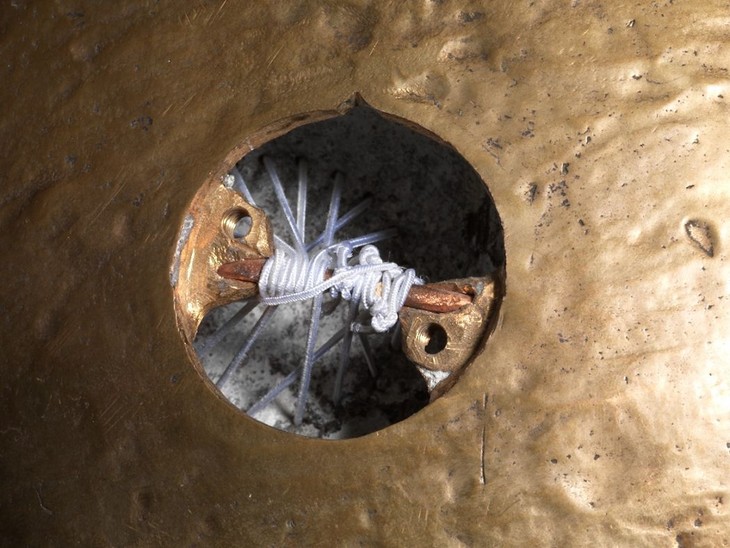
Detail of tied threads in Stringed Figure 1938, cast 1960
Tate T00386
© The Henry Moore Foundation. All Rights Reserved
Fig.2
Detail of tied threads in Stringed Figure 1938, cast 1960
Tate T00386
© The Henry Moore Foundation. All Rights Reserved

Detail of removable plate in Stringed Figure 1938, cast 1960
Tate T00386
© The Henry Moore Foundation. All Rights Reserved
Fig.3
Detail of removable plate in Stringed Figure 1938, cast 1960
Tate T00386
© The Henry Moore Foundation. All Rights Reserved
Moore would have made an original version of this sculpture in plaster, building it up in successive layers and finally adding textures to create interest in the surface. A good example of this can be seen in the striations that highlight the contours of the small circular mound to the top of the sculpture (fig.4). When complete a mould was taken from this plaster original so that the sculpture could be reproduced in bronze. This bronze was cast in an edition of twelve by the Art Bronze Foundry in London. A bronze of this size is likely to have been cast using the lost wax technique. The surface has been cleaned and polished after casting to give the finished effect and has not been artificially patinated.
Tate’s version of this sculpture is mounted vertically on its edge. Moore kept a cast of this sculpture in his own home and this particular orientation is seen in photographs taken of Moore here in the early 1960s. However, later photographs show the same sculpture displayed on its back so that the strings lie more in the horizontal plane. It has therefore been understood by collectors that Moore found it acceptable to display this sculpture in either orientation.
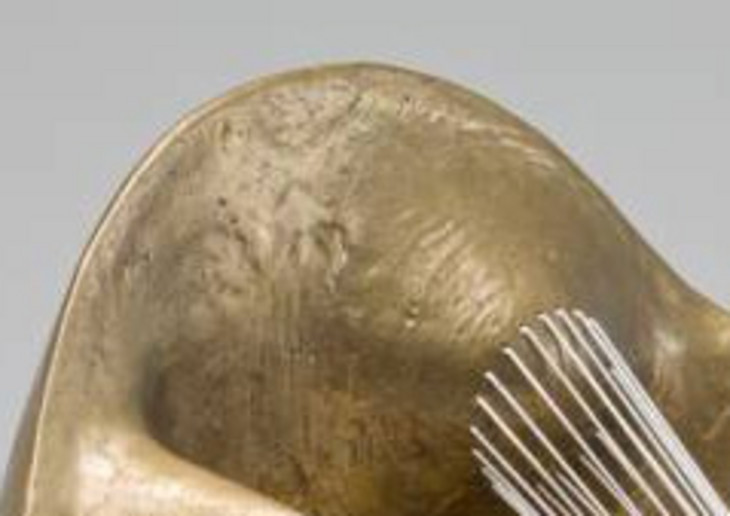
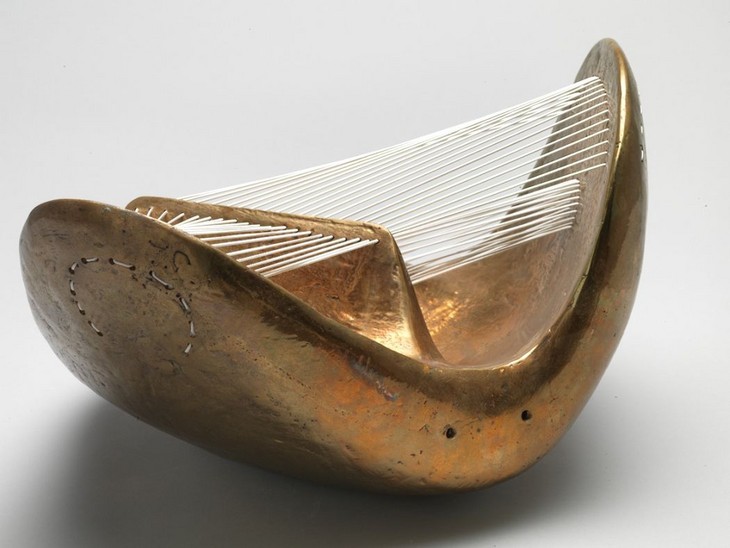

Detail of contours on Stringed Figure 1938, cast 1960
Tate T00386
© The Henry Moore Foundation. All Rights Reserved
Fig.4
Detail of contours on Stringed Figure 1938, cast 1960
Tate T00386
© The Henry Moore Foundation. All Rights Reserved

Underside view of Stringed Figure 1938, cast 1960, showing drilled holes
Tate T00386
© The Henry Moore Foundation. All Rights Reserved
Fig.5
Underside view of Stringed Figure 1938, cast 1960, showing drilled holes
Tate T00386
© The Henry Moore Foundation. All Rights Reserved
The rectangular base is made from pinewood and has been coloured with an ochre yellow varnish. The bronze is fixed with two steel screws that pass through the underside of the base and into drilled holes in the bronze (fig.5). The sculpture is unsigned.
Lyndsey Morgan
July 2013
How to cite
Lyndsey Morgan, 'Technique and Condition', July 2013, in Alice Correia, ‘Stringed Figure 1938, cast 1960 by Henry Moore OM, CH’, catalogue entry, January 2013, in Henry Moore: Sculptural Process and Public Identity, Tate Research Publication, 2015, https://wwwEntry
Stringed Figure is an asymmetrical sculpture made of bronze and two sets of elasticated strings. The bronze part of the sculpture is concave like a bowl, and has an irregular rimmed edge that curves into three rounded petal-like forms. It sits upright on its side and is attached to a pine wood base (fig.1). Within the hollowed space of the bronze are two very different protrusions. On the left-hand side is a ridge, triangular in profile, which projects outwards from the concave bronze base, forming a wall or barrier between the left-hand petal and the other two-thirds of the sculpture. The second protrusion – a rounded bump that appears to swell from the concave surface – is near the top of the sculpture in the middle.
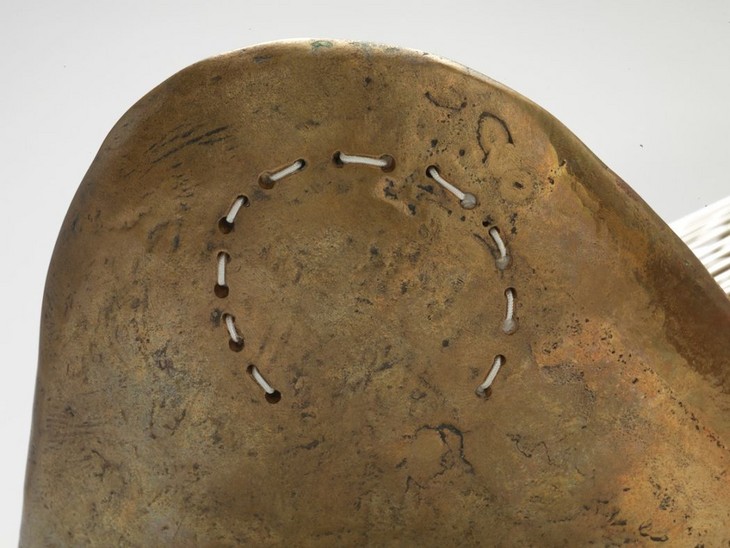
Henry Moore
Detail of stitching on Stringed Figure 1938, cast 1960
Tate T00386
© The Henry Moore Foundation. All Rights Reserved
Fig.2
Henry Moore
Detail of stitching on Stringed Figure 1938, cast 1960
Tate T00386
© The Henry Moore Foundation. All Rights Reserved

Detail of Stringed Figure 1938, cast 1960, showing stitching
Tate T00386
© The Henry Moore Foundation. All Rights Reserved
Fig.3
Detail of Stringed Figure 1938, cast 1960, showing stitching
Tate T00386
© The Henry Moore Foundation. All Rights Reserved
The triangular ridge acts as an intersection for a set of white elasticated strings which span across the sculpture from the left-hand edge to the right-hand edge. On the left near the rim, the bronze has been pierced by twenty tiny holes in the shape of an incomplete circle (fig.2). The string has been threaded through the holes, and from the rear creates a running stitch pattern. Seen from the concave front, the twenty strings extend from this near circular arrangement and stretch in a parallel formation towards the triangular prism, which has been pierced with a straight row of holes running along its top. Each string passes through one hole and out the other side of the prism, from which they fan outwards towards the right of the sculpture. The string then threads through twenty holes that parallel the curved edge of the right-hand rim so that, when seen from the rear, they form an arc of stitches (fig.3). Passing through the protruding prism the strings create a type of v-shape as they spread more-or-less horizontally inwards from the outer left edge, and then outwards towards the right edge.
Behind this curtain of strings is a second set of twenty strings. From the swelling bump at the top of the bronze, string has been threaded through twenty small holes, arranged in a circular pattern. These strings project downwards and to the right, behind the horizontally orientated strings, and are threaded through holes forming another circular pattern, but with a smaller diameter than the larger originating circle, thus forming a truncated conical shape.

Detail of tied threads in Stringed Figure 1938, cast 1960
Tate T00386
© The Henry Moore Foundation. All Rights Reserved
Fig.4
Detail of tied threads in Stringed Figure 1938, cast 1960
Tate T00386
© The Henry Moore Foundation. All Rights Reserved
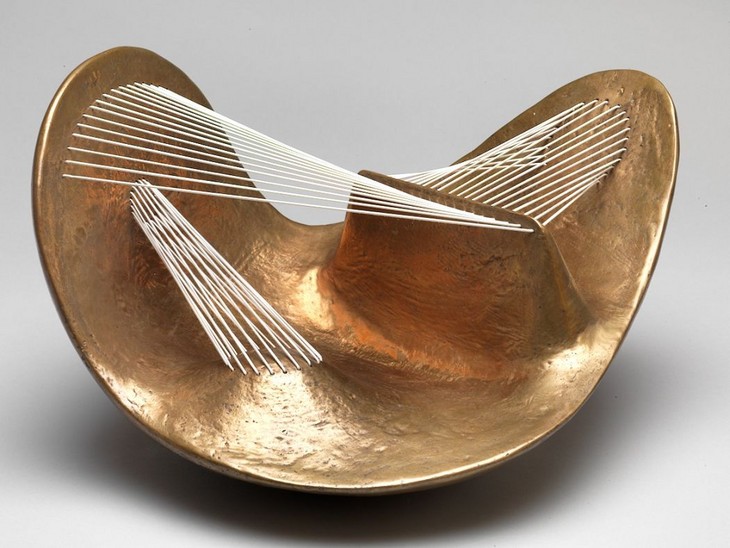
Henry Moore
Stringed Figure, 1938, cast 1960 (alternative orientation)
Tate T00386
© The Henry Moore Foundation. All Rights Reserved
Fig.5
Henry Moore
Stringed Figure, 1938, cast 1960 (alternative orientation)
Tate T00386
© The Henry Moore Foundation. All Rights Reserved
The sculpture balances upright on the inward curve of two of its outer edges and is secured to a wooden base with two screws. On the rear of the sculpture, directly behind the swelling bump is a small removable disk, held in place with two screws. When removed, it is possible to see inside the sculpture, where the tied ends of the strings are revealed (fig.4). Two nuts have been welded to a metal cross-beam and are used to hold the bronze disk in place but may also be used to secure the sculpture to the base when it is repositioned and displayed sitting on its back (fig.5).
Although cast in bronze in 1960, the idea for this sculpture originated in a wood and string sculpture made in 1938 (fig.6). In 1961, shortly after Tate acquired the bronze sculpture, Moore explained in a letter to Martin Butlin, then Assistant Keeper of the Tate collection, what the origins and circumstances were that led to the creation of the work:
The original idea of this sculpture is plate no.91B, third edition, Lund Humphries [Herbert Read (ed.), Henry Moore: Sculpture and Drawings, 1944 third edition, London 1949], and was made in wood. It was lost in Poland in the early part of the war, and has never been traced. However I came across the preliminary sketch for the sculpture (a small clay maquette) in my studio two years ago, and because I liked the original, and even thought the maquette was better than the wooden sculpture, I remade this sculpture in plaster, and had it cast into bronze in 1960; the idea is identical with the maquette.1
From about 1955 Moore began to reassess many of his unique sculptures from the 1930s made in lead, concrete and wood, and decided to cast and edition a number of them in bronze. Among these new editions was Reclining Figure (Tate T00387), which was cast in bronze in 1959 after a unique lead original made in 1939. Although Moore claimed that he re-cast Stringed Figure because he was fond of the original, his decision to edition earlier works in multiples may have been driven by financial reasons. In the early 1940s Moore had found that the sale of his small bronze maquettes, such as Maquette for Madonna and Child 1943 (Tate N05600), could off-set the costs of casting much larger sculptures in bronze. In addition, demand for Moore’s work had increased significantly by the mid-1950s. By this time he was working with a number of different London-based commercial galleries including Roland Browse and Delbanco, Gimpel Fils, and the Leicester Galleries, all of which sold small, domestic scale sculptures by Moore to a growing number of collectors.
Another reason why Moore may have wished to re-visit his original Stringed Figure may be due to the circumstances in which the wood sculpture was lost. The lignum vitae sculpture had been in the collection of Moore’s friend, John Anthony Thwaites (1909–1981). Between 1931 and 1943 Thwaites was a member of the British Foreign Service and worked in numerous cities internationally as a British Vice-Consul. From 1933 he also worked as an art critic, and contributed articles to the magazine Axis. Thwaites probably came into contact with Moore through his activities as an art critic, and in 1936–7, while posted at the British Consul in Chicago, had tried to persuade the Foreign Office to support an exhibition of Moore’s sculpture in the United States.2 However, Thwaites’s attempts proved unsuccessful, and Moore would not exhibit in an American public gallery until 1946.
In the early 1930s Thwaites had started collecting works by modern artists including Paul Klee and Wassily Kandinsky. However, his collecting came to an abrupt end in 1939 when, while working as Vice Consul in Katowice in southern Poland, he had to abandon his entire collection in his private residence due to the German invasion. During the Second World War, Thwaites’s art collection went missing and its whereabouts have never been identified. Thwaites’s collection, including his sculpture by Moore, is listed on the German government’s database of lost art.3
In re-making Stringed Figure Moore relied on his surviving un-fired white clay maquette (fig.7) and his photographic records of the original wood sculpture. Throughout the 1930s Moore had been diligent at photographing his sculptures, and it was these images that formed the basis of the monograph published by Lund Humphries that Moore mentioned in his letter to Martin Butlin. A comparison of Moore’s photograph of the wood Stringed Figure taken at his home in Kent (see fig.6) and that of its bronze descendent reveals that, despite some similarities, Moore did not make a faithful re-creation. The earlier wood version had two ridges rising from the curved base, segmenting the frontal rows of string into three. Moreover, the conical arrangement of strings passed through the larger of the ridges, which split it into two sections. The bronze section of the sculpture has been simplified in comparison, with only one ridge segmenting the strings, while the conical arrangement is positioned to one side of the ridge and is not intersected by it. However, the number of strings used in the bronze version has been increased, from eight to twenty in the front row and from nine to twenty in the conical formation. Significantly, Moore noted in his letter to Butlin that the 1960 bronze version is ‘identical with the maquette’, suggesting that although the maquette was a preparatory study for the wood version, he changed its composition during the carving process.
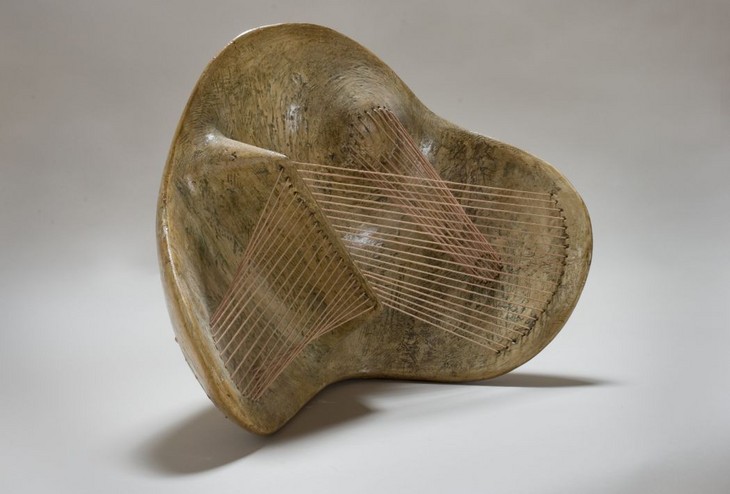
Henry Moore
Stringed Figure 1939–60
Plaster with surface colour, red string added in 1999
L: 343 mm
The Henry Moore Foundation
© The Henry Moore Foundation. All Rights Reserved
Fig.8
Henry Moore
Stringed Figure 1939–60
The Henry Moore Foundation
© The Henry Moore Foundation. All Rights Reserved
Once complete, the full-size plaster was used to create moulds for the bronze casting process. It is likely that the bronze was cast using the lost wax method. The edition of Stringed Figure was cast by the Art Bronze Foundry, London, which had previously cast Moore’s Maquette for Madonna and Child 1943–4 (Tate N05600). The foundry had been established in 1922 by Charles Gaskin and by 1953 was located just off the Kings Road in London. It is likely that Moore was introduced to the foundry during the 1930s when he taught at Chelsea College of Art, which was nearby and regularly used by staff and students.
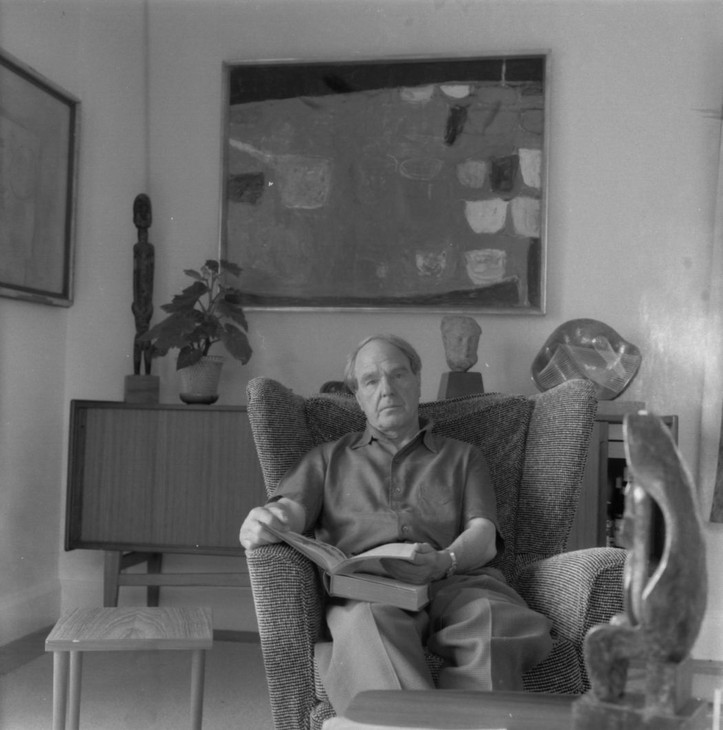
John Hedgecoe
Henry Moore
The Henry Moore Foundation
© The Henry Moore Foundation. All Rights Reserved
Fig.9
John Hedgecoe
Henry Moore
The Henry Moore Foundation
© The Henry Moore Foundation. All Rights Reserved
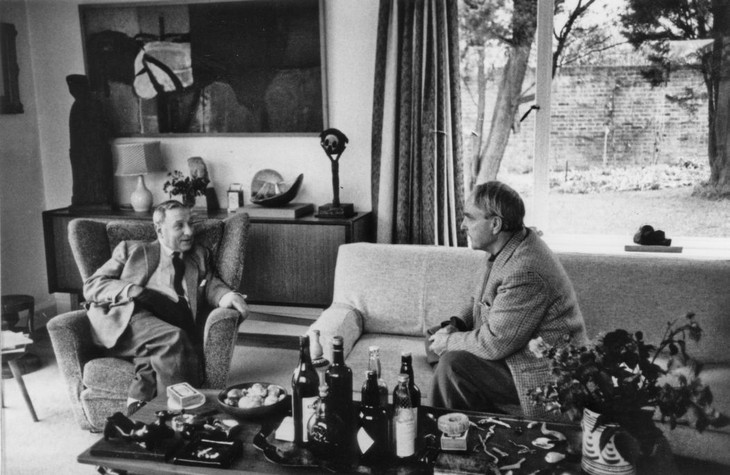
Henry Moore and Joseph H. Hirshorn in Moore's living room at Hoglands 1962
© The Henry Moore Foundation. All Rights Reserved
Fig.10
Henry Moore and Joseph H. Hirshorn in Moore's living room at Hoglands 1962
© The Henry Moore Foundation. All Rights Reserved
It is perhaps testament to Moore’s fondness for this work that an example of the sculpture was kept in the living room of his home. In the early 1960s Moore was photographed sitting in front of the sculpture by John Hedgecoe (fig.9). In the photograph, Stringed Figure is displayed as it is at Tate, standing on its edge so that the strings create a horizontal fence between the viewer and the interior of the curved bronze. However, another photograph taken in late 1962 shows the sculpture in the same spot in Hoglands but positioned on its back (fig.10). Indeed, when the work entered the Tate collection, photographs of the sculpture provided by Moore illustrated that the sculpture could also be exhibited lying on its back. The Arts Council exhibits its edition of Stringed Figure in this alternative orientation, so that the strings form a ceiling over the bronze.5 The artist’s daughter Mary Moore has stated that it was not unusual for Moore to orientate his works in two or more different positions, and that she prefers Stringed Figure on its back, ‘when it sits just there’.6
To date, Moore’s various stringed sculptures cast during the 1960s have been discussed by art historians and critics as though they dated from the late 1930s, when their unique originals were made in lead, concrete or wood. For example, in 1968 the critic David Sylvester discussed Moore’s wood and bronze stringed sculptures together, finding the delayed casting unproblematic since, for him, stringed works were ‘made to be cast’, adding that ‘a few pieces not cast at the time have been cast in bronze at various times since’.7 While Moore may have had different, unrecorded objectives for creating Stringed Figure in 1960, it is nonetheless instructive to consider the sculpture in light of the use he made of strings between 1937 and 1941.
In 1968 Moore accounted for his interest in strings:
Undoubtedly the source of my stringed figures was the Science Museum ... I was fascinated by the mathematical models I saw there, which had been made to illustrate the difference of the form that is half-way between a square and a circle. One model had a square stone end with twenty holes along each side making eighty holes in all. Through these holes strings were threaded and led to a circle with the same number of holes at the other end. A plane interposed through the middle shows the form that is halfway between a square and a circle. One end could also be twisted to produce forms that would be terribly difficult to draw on a flat surface. It wasn’t the scientific study of these models but the ability to look through the strings as with a bird cage and to see one form within another which excited me.8
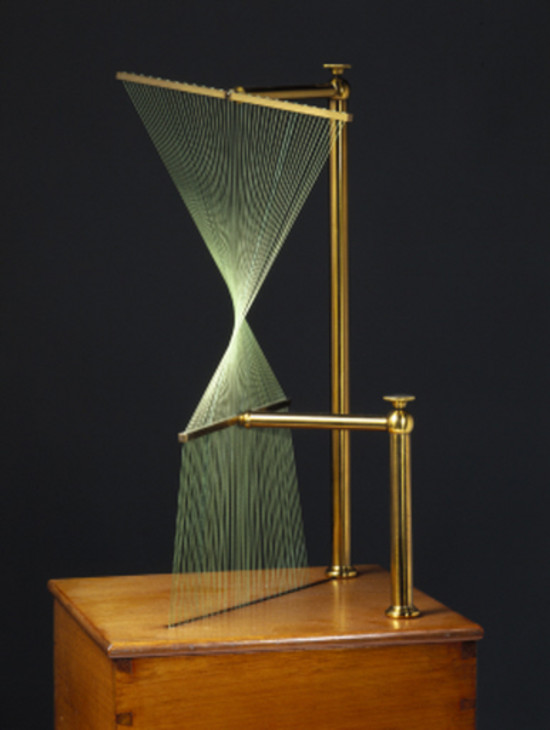
Fabre de Lagrange
String Surface Model: Hyperbolic Paraboloid 1872
Science Museum, London
Fig.11
Fabre de Lagrange
String Surface Model: Hyperbolic Paraboloid 1872
Science Museum, London
There may be no single reason why Moore started using strings in 1937. However the art historians Martin Hammer and Christina Lodder have noted that ‘fascination with mathematical models was in fact widespread in the artworld in the mid-1930s’.12 Artists working within the tenets of constructivism or surrealism, both of which were major tendencies of the period, had identified the aesthetic potential of mathematical models with strings.
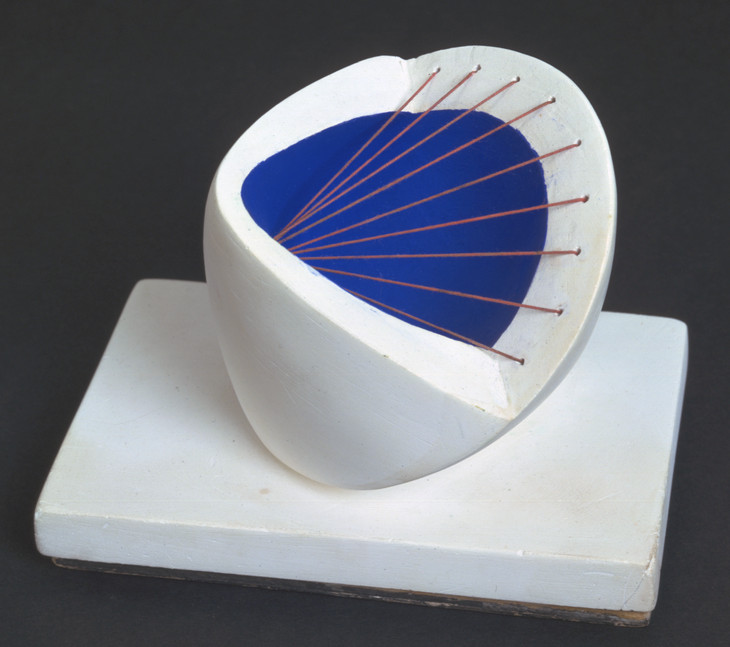
Dame Barbara Hepworth 1903–1975
Sculpture with Colour (Deep Blue and Red) 1940
Plaster and string on plaster base
object: 105 x 149 x 105 mm
Tate T03133
Presented by the executors of the artist's estate 1980
© Bowness
Fig.12
Dame Barbara Hepworth
Sculpture with Colour (Deep Blue and Red) 1940
Tate T03133
© Bowness
In the publication Circle: International Survey of Constructive Art published in 1937, the editors Gabo, Nicholson and architect Leslie Martin set out the constructivist belief in an integrated modern society, where art, architecture and design could be incorporated into everyday life. Circle included contributions from Hepworth and Moore, as well as from architects Marcel Breuer and Walter Gropius, and the scientist J. Desmond Bernal. As a platform for constructive art, Circle advocated a type of abstraction that embraced new forms and materials and methods of construction.
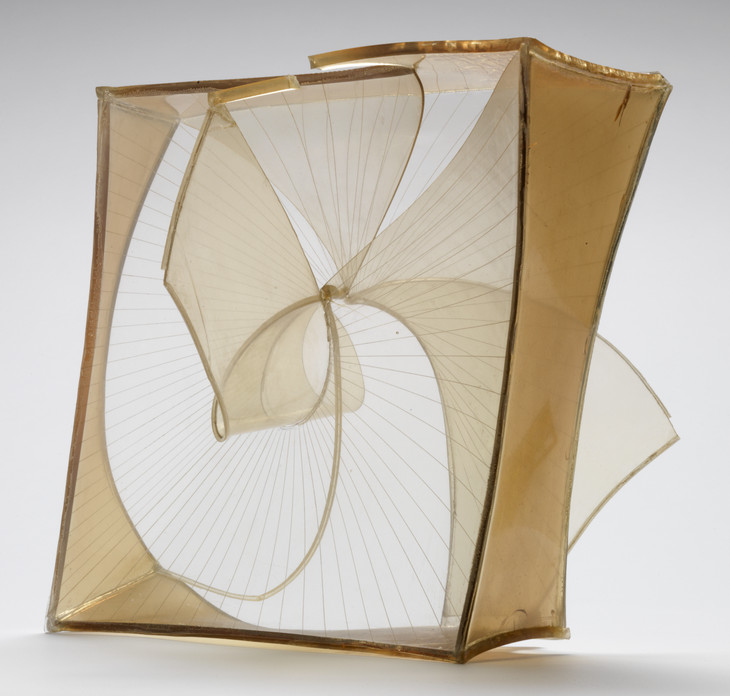
Naum Gabo 1890–1977
Construction in Space (Crystal) 1937–9
Cellulose acetate
object: 220 x 270 x 180 mm
Tate T06978
Bequeathed by Miriam Gabo, the artist's widow 1995
The Work of Naum Gabo © Nina & Graham Williams/Tate, London 2014
Fig.13
Naum Gabo
Construction in Space (Crystal) 1937–9
Tate T06978
The Work of Naum Gabo © Nina & Graham Williams/Tate, London 2014
In May 1936 the mathematical models, many of which incorporated strings, held in the Poincaré Institute became widely known within artistic circles due to their inclusion in the surrealist exhibition Exposition surréaliste d’objets at the Galerie Ratton in Paris. In addition to the exhibition, photographs of the models taken two years earlier by Man Ray were published in the art journal Cahiers d’Art.18 Man Ray had taken his photographs of the mathematical models at the suggestion of Max Ernst, and the images explored their sculptural, architectural, and three-dimensional characteristics through the use of raking light and extreme shadows. The May 1936 edition of Cahiers d’Art was a special issue was devoted to surrealist objects and as a regular reader of the journal it is probable that Moore not only knew of Man Ray’s photographs, but also understood how the models could themselves be understood as found surrealist objects. It is also likely that Moore met Man Ray in London in June 1936; Moore was on the selection committee for the International Surrealist Exhibition held at New Burlington Galleries in London, and Man Ray, who was exhibiting work, came to London for the exhibition and met with most of the exhibition organisers.19

Man Ray
Mathematical Object 1934–6
Photograph, gelatin silver print on paper
Art Gallery of New South Wales
© Man Ray/ADAGP. Licensed by Viscopy, Australia
Fig.14
Man Ray
Mathematical Object 1934–6
Art Gallery of New South Wales
© Man Ray/ADAGP. Licensed by Viscopy, Australia
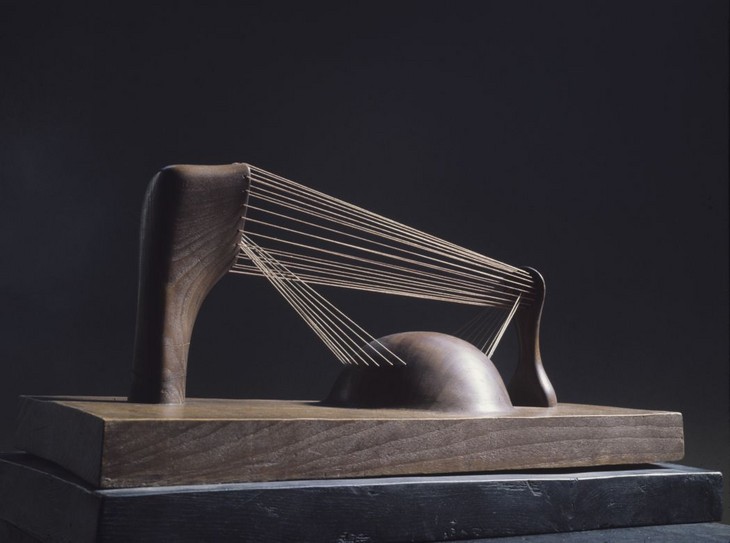
Henry Moore
Stringed Relief 1937
Graphite on cream medium-wove paper
279 x 184 mm
The Henry Moore Foundation
© The Henry Moore Foundation. All Rights Reserved
Fig.15
Henry Moore
Stringed Relief 1937
The Henry Moore Foundation
© The Henry Moore Foundation. All Rights Reserved
The unusual shapes of the mathematical objects and the use of shadow and line in Man Ray’s photographs, coupled with his prior knowledge of the use of strings in the mathematical models, perhaps offered Moore a way of marrying his interest in both the tense linearity of constructivism and surrealist transformation. Formal affinities can be seen between the base of one of the mathematical models pictured by Man Ray (fig.14), with its two upright forms and central oval relief, with Moore’s Stringed Relief 1937 (fig.15). This beechwood sculpture presents two unequally sized upright forms positioned on a rectangular base, separated by a hemispherical mound. The three elements of the sculpture are linked by three arrangements of strings. Works such as Stringed Relief were developments of Moore’s multi-part sculptures of the early 1930s in which, in his own words, he ‘began separating forms from each other in order to be able to relate space and form together’.20
In drawings such as Ideas for Stringed Figures 1938 (fig.16) it is clear that Moore continued to think about the individual sculpted elements and their relationships within space, but also how the interconnectedness of parts within a single sculpture might be demonstrated. Although Stringed Figure cannot be pinpointed to a single drawing, the sketches in the top row on the left, and in the second row on the right, illustrate how Moore sought to use strings to bridge two opposing sides of a sculpture with a central protruding meeting point.
The curator and critic David Sylvester suggested in 1948 that in his stringed sculptures Moore’s focus was on space, volume and the interplay between masses and voids. According to Sylvester, the tautly arranged strings created ‘“Sculpture in air” ... because the hollow is no longer open and limitless, but is given shape on its open side: the space remains visible but its limits are now defined on all sides; it is a form in air’.21 The space that is so important in works such as Head and Ball 1934 (The Henry Moore Foundation) is made explicit in Moore’s stringed sculptures: the arrangement of strings linking the two side edges of Stringed Figure contain and quantify the space within the hollowed bronze bowl.
The reception of Moore’s stringed sculptures by art critics and historians was fairly consistent from the 1950s through to the 1970s. Most interpretations of Moore’s stringed sculptures followed Sylvester’s discussion of mass and space, noting how the layered strings created sculptural depth. In 1959, 1965 and 1973, Erich Neumann, Herbert Read and John Russell respectively reproduced the same extended quote from Moore’s 1951 Tate exhibition catalogue written by Sylvester:
The function of the string or wire is three-fold. It contrasts, in its tautness, with the curvilinear contours of the mass. It establishes a barrier between the space enclosed by the sculpture’s mass and the space which surrounds the sculpture – only, a barrier which, being a cage and not a wall, can contain the space on its open side while allowing it to remain visible. Above all, the string provokes movement of the spectators eye along its length and thereby increases his awareness of the space within the sculpture – especially when ... one set of strings can be seen through another, so creating a counterpoint of movement which brings to life the space around and within which the strings operate.22
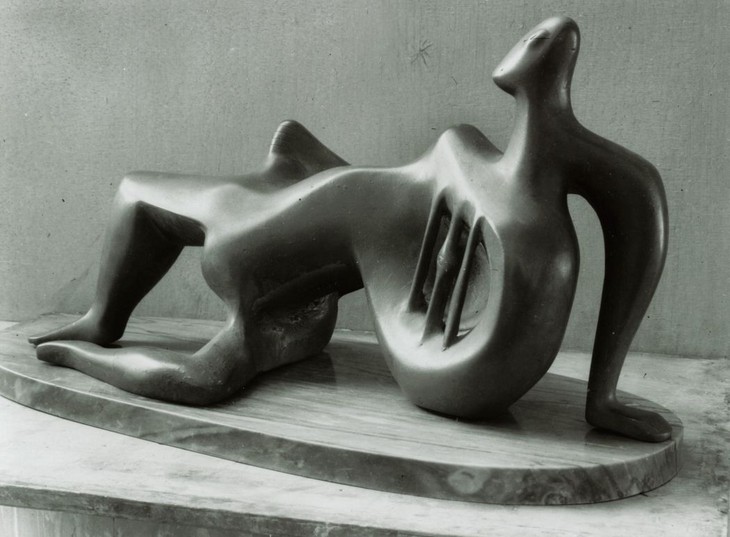
Henry Moore
Reclining Figure 1931
Lead
© The Henry Moore Foundation. All Rights Reserved
Fig.17
Henry Moore
Reclining Figure 1931
© The Henry Moore Foundation. All Rights Reserved
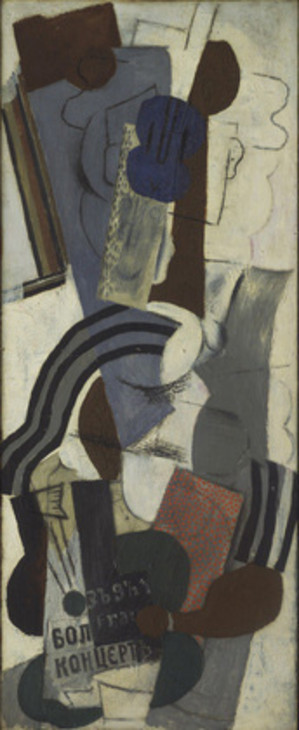
Pablo Picasso
Woman with a Guitar 1914
Oil paint, sand and charcoal on canvas
1155 x 475 mm
The Museum of Modern Art, New York
© 2013 Estate of Pablo Picasso / Artists Rights Society (ARS), New York
Fig.18
Pablo Picasso
Woman with a Guitar 1914
The Museum of Modern Art, New York
© 2013 Estate of Pablo Picasso / Artists Rights Society (ARS), New York
The prevalence of this description of Moore’s use of strings exemplifies the consistency of the literature on his work throughout the artist’s lifetime. However, in 2004 curator Anita Feldman Bennet proposed another way of thinking about Moore’s use of strings.23 In her analysis of Moore’s interactions with space and string, Feldman Bennet proposed that his earlier lead sculpture Reclining Figure 1931 (fig.17) echoes ‘Picasso’s recurring motif of the female figure as a guitar ... anticipating Moore’s sculptural use of strings’.24 In the sculpture, a hollowed cavity in the figure’s torso is fenced in by three parallel bars; in light of Picasso’s cubist paintings such as Woman with a Guitar 1914 (fig.18), in which the female body and the instrument coalesce, it may be possible to view Moore’s Reclining Figure, and the later Stringed Figure, as a formal development of this notion of the body as instrument. This proposition is supported by the title of Tate’s sculpture, which is identified as a stringed ‘figure’.
In 1979 the curator Richard Morphet proposed that one of the reasons Moore stopped creating multi-part sculptures such as Head and Ball and Four-Piece Composition: Reclining Figure 1934 (Tate T02054) in the mid-1930s was that in continuing along this trajectory, Moore ‘would in his view have run the risk of the viewer losing track of the fundamental subject of this and all his work, the human figure’.25 Moore’s dedication to the human form as a means of expressing ‘human psychological content’,26 may also account for the cessation of his use of strings:
I could have done hundreds. They were fun, but too much in the nature of experiments to be really satisfying. That’s a different thing from expressing some deep human experience one might have had. When the war came, I gave up this type of thing. Others, like Gabo and Barbara Hepworth, have gone on doing it. It becomes a matter of ingenuity rather than a fundamental human experience.27
According to the critic Peter Fuller, Moore preferred the imaginative and emotive possibilities of his type of organic sculpture over the stricter and seemingly unemotional use of strings in Gabo’s constructivist works. For Fuller, Moore’s work was rooted in an essentially English romantic landscape tradition and cumulatively eschewed the materials, forms and constructions of modern life. He argued: ‘basically Moore was not interested in the idea of avant-garde innovation as an end in itself; rather, formal devices were, for him, simply a way of bringing about such transformations and metemorphoses of natural form as might enable him to intensify the emotive content of his work.’28 In 1981 Moore elaborated further, explaining that Gabo ‘developed this string idea so that his structure always became space itself ... I like the contrast between the solid and the strings. The string and the “open” idea was the side I was trying to relate and develop’.29 This interest in the relationship between the individual elements of a single sculpture and how they might be wrapped or enveloped would be further explored in works such as Upright Internal/External Form 1952–3 (Tate T02272).
Tate held thirteen sculptures by Henry Moore in its collection prior to the acquisition of Stringed Figure in 1960. Since a large number of these were small maquettes, by the late 1950s the trustees of the Tate were keen to expand the gallery’s holdings of Moore’s work. Acquisitions of Moore’s work had been hindered since the 1930s, first by J.B. Manson, Tate’s director between 1930 and 1938, who disliked modern art and who told Tate trustee Robert Sainsbury ‘Over my dead body will Henry Moore ever enter the Tate’,30 and then by Moore’s subsequent post as a trustee of the gallery from 1941–8 and then 1949–56.31
After stepping down from his role as a trustee, Moore discussed a number of sculptures that could be made available to Tate with the gallery’s then director, Sir John Rothenstein. Moore proposed a list of eight works, which was presented to the trustees at their meeting on 16 May 1957.32 Although this proposed purchase did not occur immediately, the list, which included an example of each of Moore’s different subjects and materials to date, became the blueprint used by the Friends of the Tate for their acquisition of six sculptures by Moore in 1960. A letter to Moore dated 1961 from Jane Lascelles, organising secretary for the Friends, notes that there was no correspondence about the acquisition of these sculptures in the Friends’ files, suggesting that the particulars of the sale – including the cost of each work – were agreed verbally with Moore.33 In addition to Stringed Figure the other sculptures presented to the gallery in December 1960 were Composition 1932 (Tate T00385); Reclining Figure 1939 (Tate T00387); Helmet Head No.1 1950 (Tate T00388); Mother and Child 1953 (Tate T00389); and Working Model for Unesco Reclining Figure 1957 (Tate T00390).
An edition of twelve plus one artist’s cast was made of Stringed Figure. Other examples are held in the Henry Moore Family Collection and the Arts Council Collection while the remaining works are believed to be held in private collections.34
Alice Correia
January 2013
Notes
Henry Moore, letter to Martin Butlin, 13 April 1961, Tate Artist Catalogue File, Henry Moore, A23942.
Henry Moore, Stringed Figure 1938, Arts Council Collection, http://www.artscouncilcollection.org.uk/artwork/stringed-figure , accessed 10 September 2015.
Mary Moore, ‘Stringed Figure’, in Gregor Muir (ed.), Henry Moore: Ideas for Sculpture, exhibition catalogue, Hauser & Wirth, London 2010, p.130.
Jane Wess, ‘The History of Mathematical Surface Models’, in Intersections: Henry Moore and Stringed Surfaces, exhibition catalogue, Royal Society and Science Museum, London 2012, p.7.
Martin Hammer and Christina Lodder, ‘Hepworth and Gabo: A Constructivist Dialogue’, in David Thistlewood (ed.), Barbara Hepworth Reconsidered, Liverpool 1996, p.116.
Steven A. Nash, ‘Moore and Surrealism Reconsidered’, in Dorothy Kosinski (ed.), Henry Moore: Sculpting the 20th Century, exhibition catalogue, Dallas Museum of Art, Dallas 2001, p.48.
J. Desmond Bernal, ‘Art and the Scientist’, in Leslie Martin, Ben Nicholson and Naum Gabo (eds.), Circle: International Survey of Constructive Art, London 1937, pp.119–23.
See Jacky Klein, ‘Model for ‘Construction in Space ‘Crystal’’ 1937 by Naum Gabo’, summary, September 2002, http://www.tate.org.uk/art/artworks/gabo-model-for-construction-in-space-crystal-t02179/text-summary , accessed 14 January 2013.
For an online copy of the exhibition catalogue of the 1936 International Surrealist Exhibition see http://www.romanianculture.org/downloads/Surrealism%20Catalogue.pdf , accessed 10 September 2012. For installation images of mathematical models on display in the Exposition surréaliste d’objets in 1936 see Dawn Ades (ed.), Dada and Surrealism Reviewed, exhibition catalogue, Hayward Gallery, London 1978, pp.322, 450.
David Sylvester, ‘The Evolution of Henry Moore’s Sculpture: I’, Burlington Magazine, vol.90, no.543, June 1948, p.164.
David Sylvester, Henry Moore, exhibition catalogue, Tate Gallery, London 1951, p.16, as quoted in Erich Neumann, The Archetypal World of Henry Moore, London 1959, p.69. See also Herbert Read, Henry Moore: A Study of his Life and Work, London 1965, pp.121–2, and John Russell, Henry Moore, London 1973, p.90.
Anita Feldman Bennet, ‘Surrealism, Space and String: Henry Moore’s Bird Basket’, in Henry Moore at Dulwich Picture Gallery, exhibition catalogue, Dulwich Picture Gallery, London 2004, pp.25–33.
[Richard Morphet], ‘Henry Moore: Four-Piece Composition 1934’, The Tate Gallery 1976–8: Illustrated Catalogue of Acquisitions, London 1979, p.120.
Henry Moore, ‘A Sculptor Speaks’, Listener, 18 August 1937, pp.338–40, reprinted in Alan Wilkinson (ed.), Henry Moore: Writings and Conversations, London 2002, p.198.
Henry Moore cited in Carlton Lake, ‘Henry Moore’s World’, Atlantic Monthly, January 1962, p.42, reprinted in Wilkinson 2002, p.256.
Minutes of Meeting of the Trustees of the Tate Gallery, 16 May 1957, Tate Public Records TG/4/2/742/2.
See Mary Moore 2010, p.130, and the Arts Council Collection, http://www.artscouncilcollection.org.uk/collection , accessed 10 September 2015.
Related essays
- Henry Moore: The Plasters Anita Feldman
- ‘An essentially different kind of rhythm’: Rediscovering Henry Moore’s Sculpture in Wood Ann Compton
- Henry Moore's Approach to Bronze Lyndsey Morgan and Rozemarijn van der Molen
Related catalogue entries
Related material
-
Henry MooreLetter to Raymond Coxon and Edna Ginesi (Peacham & Gin) Late August/ early September 1936Letter
How to cite
Alice Correia, ‘Stringed Figure 1938, cast 1960 by Henry Moore OM, CH’, catalogue entry, January 2013, in Henry Moore: Sculptural Process and Public Identity, Tate Research Publication, 2015, https://www

